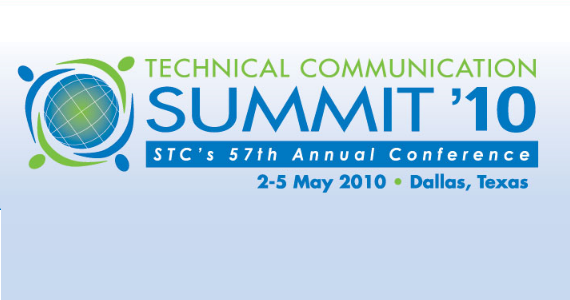What I'm Presenting on at the Dallas Summit
At the STC Summit in Dallas this year (May 2-5), I'll be giving a presentation titled "Developing a Personal Voice in Audio." I'm moving in the direction of screencasts, focusing on the audio component in this presentation.

Here's the presentation description:
Narrated video tutorials -- both scripted and spontaneous -- are a powerful tool tech writers can employ to help users learn software. But the audio component of a video tutorial can be challenging. Both the audio processing and personal delivery pose challenges for tech writers, whose strength may be the written word rather than audio. Often the voice component of these video tutorials is outsourced to "voice talent." But what do professionals with voice talent know that regular tech writers don't? By imagining a situation, adding inflection, learning to breathe and pause, and integrating other voiceover techniques, you can develop a personable, friendly voice that engages users. You can also give your voice a deeper, richer sound by using the right microphone in the right acoustic environment and applying several post-processing techniques.
People who attend the session will learn the following:
- How to choose the right microphone, set up a makeshift sound booth, record and post-process sound.
- How to deliver audio for a tutorial in a way that users find personable, friendly, and engaging.
- How to avoid pitfalls in audio that drag a video tutorial down, such as speaking monotonously, falling into a predictable rhythm, or popping P's.
I'm actually working on about 25 Joomla screencasts at work right now. (Joomla is an amazing CMS, by the way.) Last month I created a guide for web administrators across the globe to build country websites, basically a simple version of LDS.org in their language. About a month after creating the guide, the PM said to me, hey, we're wondering if you could do some videos too.
Why the videos? Wasn't the guide enough? No, because that's not how the majority of people learn software. A software application is a visual experience -- the buttons, the layout, colors, movement, the functionality. It makes sense that a visual learning mode (e.g., screencasts) would be the most helpful in learning a visual interface. I know that when I'm looking to learn a new program from scratch (not just looking up a specific information for an application I already know), video tutorials appeal to me. When I see, I understand. And videos are exploding all over the web -- because videos appeal to others as well. We are visual learners, for the most part.
There's a lot to learn about screencasting. You could be a full-fledged sound engineer, videographer, voiceover artist, and interactive multimedia producer before you feel completely comfortable. Screencasts combine all of these elements into one experience.
For the Dallas presentation, I've narrowed the scope considerably to focus only on voice. Even a dull screen can come alive with an engaging, warm, interesting voice.
If you have any tips, tricks, resources, or other insight in developing a personal voice in audio, let me know.
About Tom Johnson

I'm an API technical writer based in the Seattle area. On this blog, I write about topics related to technical writing and communication — such as software documentation, API documentation, AI, information architecture, content strategy, writing processes, plain language, tech comm careers, and more. Check out my API documentation course if you're looking for more info about documenting APIs. Or see my posts on AI and AI course section for more on the latest in AI and tech comm.
If you're a technical writer and want to keep on top of the latest trends in the tech comm, be sure to subscribe to email updates below. You can also learn more about me or contact me. Finally, note that the opinions I express on my blog are my own points of view, not that of my employer.
